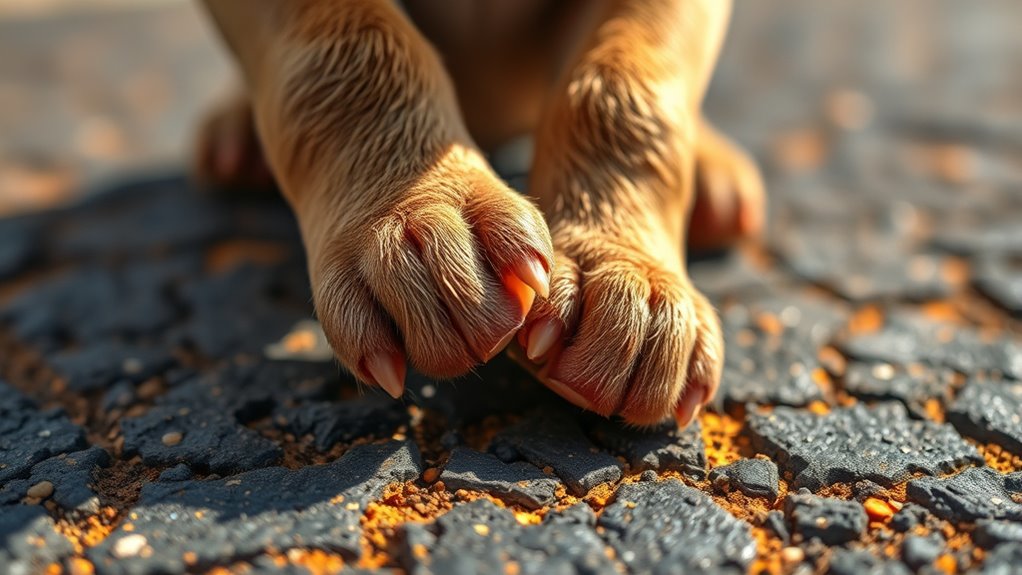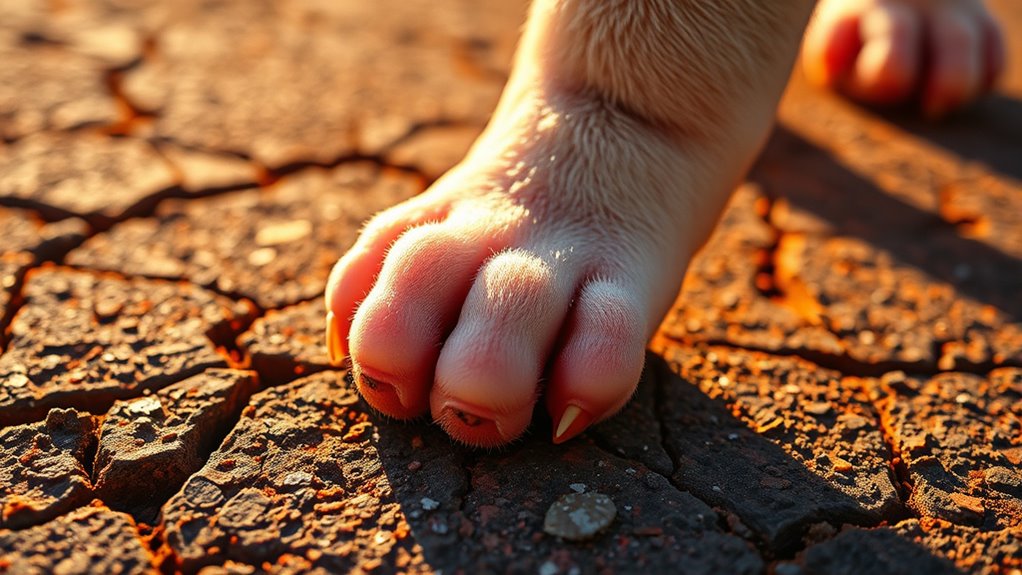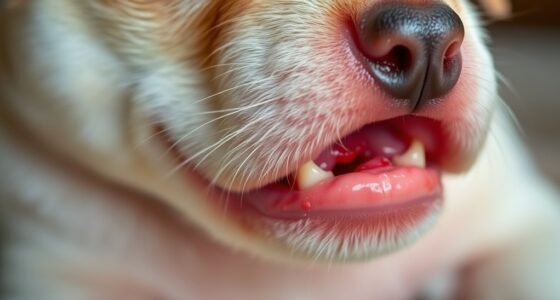Hot pavement can hide serious dangers for your puppy’s paws, including painful burns, blisters, infections, and even dehydration from licking. Surfaces like asphalt and concrete can become dangerously hot, especially during midday, causing injuries that aren’t always obvious right away. Walking during cooler times or on grassy patches helps protect your puppy. To keep your furry friend safe, learn how to spot risks and prevent these hidden dangers from affecting their health.
Key Takeaways
- Hot pavement can cause painful burns and blisters on puppy paw pads, often without immediate visible signs.
- Elevated surface temperatures increase the risk of infections, injuries, and dehydration from excessive licking.
- Pavement can reach over 140°F, causing burns in minutes, especially during midday and in direct sunlight.
- Shaded, grassy, or cooler surfaces are safer alternatives, and testing pavement with the back of your hand helps prevent injuries.
- Using protective booties and avoiding walks during peak heat hours significantly reduces the hidden dangers to puppy paws.

During hot weather, your puppy’s paws can face serious risks from scorching pavement. The intense heat can cause paw pad burns, which are painful injuries that may not be immediately obvious. When your puppy walks on hot surfaces, the heat transfers quickly to their sensitive paw pads, risking burns that can lead to redness, blistering, or even open wounds. These injuries make it painful for your puppy to walk and can become infected if not treated promptly. Additionally, hot pavement doesn’t just cause burns; it also contributes to dehydration risks. When your puppy’s paws are burning from walking on hot ground, they tend to lick their paws more frequently, which can lead to dehydration if they’re not drinking enough water. Dehydration can cause serious health problems, including weakness, dizziness, and even heatstroke, especially in young or small puppies who are more vulnerable to temperature extremes.
Hot pavement can cause painful paw burns and dehydration in puppies during summer walks.
You might not realize just how hot the pavement can get, especially during midday when the sun is at its peak. Asphalt and concrete absorb and radiate heat, often reaching temperatures that are far more dangerous than the air temperature. For example, pavement can hit temperatures over 140°F (60°C) on a hot day, which is enough to cause paw pad burns in just a few minutes of contact. The risk increases if your puppy is small, has light-colored paws, or has delicate skin. It’s essential to be aware of these dangers and take precautions to protect your pup’s paws from the scorching surface. Pavement temperatures can vary widely based on surface color and material, further influencing the risk level.
To prevent paw pad burns, you should avoid walking your puppy during the hottest parts of the day, typically between 10 a.m. and 4 p.m. When you do walk outside, choose shaded areas or grassy patches where the surface isn’t as hot. You can also test the pavement’s temperature by placing the back of your hand on it for a few seconds; if it’s uncomfortable for you, it’s too hot for your puppy’s paws. Wearing protective booties can also shield their paws from direct contact with hot pavement, reducing the risk of burns and dehydration. Remember to keep your puppy well-hydrated, offering water before, during, and after walks, especially on hot days.
Being vigilant about these dangers helps prevent painful injuries and health issues. Your puppy’s comfort and safety depend on your awareness of how hot pavement can harm their paws and their overall health. Always prioritize their well-being by taking steps to minimize these hidden dangers during the summer months.
Frequently Asked Questions
Can Hot Pavement Cause Long-Term Paw Damage?
Hot pavement can cause long-term paw damage if you’re not careful. When pavement gets too hot, it can burn your puppy’s paw pad, especially if there’s no pavement insulation to protect their sensitivity. Repeated exposure can lead to permanent paw pad damage, reducing their paw pad sensitivity over time. Always check pavement temperature and limit walks during hot weather to prevent lasting harm to your puppy’s paws.
How Quickly Can Puppy Paws Burn on Hot Pavement?
You might wonder how quickly puppy paws can burn on hot pavement. It depends on outdoor temperature and paw pad sensitivity, but generally, pavement reaches dangerous temperatures that can cause burns in just 5 to 10 minutes. When outdoor temperatures are high, your puppy’s paw pads are more vulnerable, so it’s essential to check the pavement’s temperature and keep walks brief or avoid hot surfaces altogether to protect those sensitive paws.
Are Certain Pavement Surfaces More Dangerous Than Others?
Did you know that asphalt can reach temperatures up to 140°F in just 20 minutes? Some pavement materials, like black asphalt, absorb more heat, making them more dangerous for puppy paws. Concrete and shaded areas stay cooler, reducing risks. Always check pavement temperature and seek shaded spots, especially during peak sunlight, to protect your puppy’s paws from burns. Your quick decisions can prevent painful injuries.
What Signs Indicate a Puppy’S Paws Are Injured?
You’ll notice paw pad injuries if your puppy licks or chews their paws excessively. Watch for blister symptoms like swelling, redness, or blisters on their paw pads. Your puppy may limp or show reluctance to walk, indicating pain. Keep an eye out for paw pad injuries that cause bleeding or crusting, and remember, hot pavement can worsen these issues. Promptly check and soothe their paws to prevent further damage.
How Can I Test Pavement Temperature Safely?
You can test pavement temperature safely by placing the back of your hand on the surface for about 5 seconds—if it feels too hot, it’s likely harmful. Remember, pavement insulation varies, so always check often during hot days. Use paw cooling methods like walking your puppy early or on shaded paths, and carry a portable fan or water to keep their paws cool. Always prioritize your pup’s comfort and safety.
Conclusion
Just like a delicate flower wilts in harsh sunlight, your puppy’s tiny paws can suffer irreparable damage from scorching pavement. Always be mindful of the heat, especially during peak sun hours, and test the surface before heading out. Protect your furry friend’s paws like a knight shields their castle—because their comfort and safety are worth every precaution. Remember, a little care now can prevent a lot of pain later. Keep those paws cool and safe!










